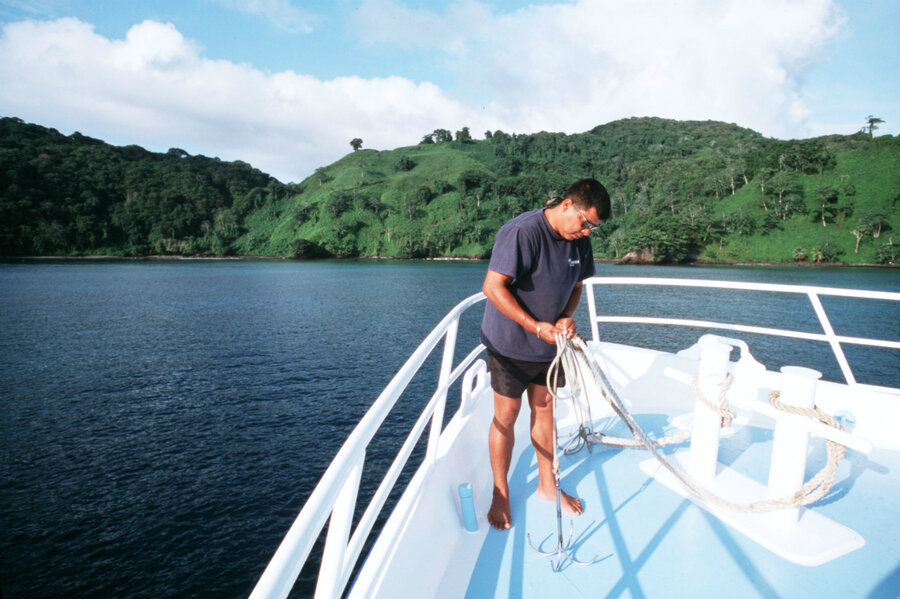Warming oceans threaten Costa Rica's biodiversity and tourism industry
Loading...
| Bahía Ballena, Costa Rica
In good years, more than 100,000 tourists flock to this marine park on Costa Rica’s Pacific coast to see humpback whales breaching in the blue waters.
But warming temperatures – driven by climate change and strengthening El Niño events – are beginning to threaten the region’s tourism economy.
“When temperatures rise two or three degrees [Celsius] above the region’s average, we have very few whale sightings compared to normal years,” said whale specialist José David Palacios, who works at the Marino Ballena National Park with the Keto Foundation, a Costa Rican marine conservation organization.
“Typically, there are many sightings a day. When temperatures rise, there are only one or two a week,” he said.
For Julio Badilla, the operator of Dolphin Tours, that’s bad news. Over the three most recent tour seasons, including a strong 2015-2016 El Niño period, whale sightings have been “terrible,” he said.
Whales are one of the main tourist draws for Marino Ballena National Park, one of Costa Rica’s most visited natural areas. As climate change hits the country’s parks and biodiversity, it is also threatening local economies highly dependent on tourism, scientists and local people say.
“What’s happening with the whales is concerning. In previous years (2015-2016) there was a decrease in the amount of tours precisely because the probability of finding whales was very low,” said Rafael Sanchez, a tour operator from the company Adventure Bay.
Scientists similarly have noticed a drop in whale sightings in the park, mainly in warmer-than-average years, they said.
Although more study is needed, they believe rising water temperatures may be altering the migration routes of humpback whales moving past Costa Rica from the north.
When the whales descend in search of warmer waters to reproduce, they may now be finding them before reaching the park, scientists believe. The problem is that, as the whales spend time elsewhere, the community of Bahía Ballena could see its income dry up.
“Whale sighting tourism really moves this community. Tourism has been the main economic activity in the region for a couple of years now. Recently, it’s been growing in these type of activities,” said Mr. Sanchez, the tour operator.
A study published in the journal Nature in 2014 estimated that extreme El Niño events, like the recent one in Costa Rica, will become twice as likely due to climate change.
That is a growing worry for tour operators in Bahía Ballena.
Along with altering whale migration, climate change is causing other problems as well, from coral bleaching to rising sea level, Mr. Palacios said.
A drop in tourism in the region would mean a big hit for Costa Rica’s tourism economy. According to data from the Costa Rican Institute of Tourism, the park is the third most visited in the country with over 130,000 tourists per year.
Less beach, dead coral
While a decrease in whale sightings is the most direct economic threat to the park, other changes – such as a loss of beach area to sea level rise – are causing concern as well.
“We’re losing beach, which is affecting tourism activity because that space available for recreation and tourism is retreating,” explained Catalina Mora, executive president of the Keto Foundation.
In the 1980s, a series of stone blocks were installed along the beach, about 50 yards from the water, to protect fragile coastal plants from waves during strong storms, she said.
Today, during high tide, the blocks sit entirely underwater.
“The water is reaching some forest paths,” said Ms. Mora, a scientist. “It’s also reaching the first line of palm trees along the coast” and eroding the soil from the roots of the trees, she said.
Marino Ballena’s coral reefs also are feeling the heat. Almost all the coral in the park suffered some bleaching in 2015, said Palacios, a marine biologist.
By 2016, 94 percent of the park’s corals were bleached and today almost 90 percent have died, he said. That is a huge worry for tour operators because snorkeling on the reefs has been another major tourism draw, the scientist said.
Adapting?
With the surrounding community depending on the health of the park for an income, park backers are pushing for adaptation measure to try to limit damage to the reserve.
For instance, Mora said her organization is pushing for more sustainable tourism practices, including changing snorkeling and whale watching areas regularly to ensure the same ones are not overstressed.
The foundation also is urging that more palm trees be planted along the coast to serve as a defense barrier against erosion and big waves, Palacios said.
However, tour operators say the problem of continuing warming in the reserve can only be solved by global action to limit climate change.
Because of this lack of local control over the ongoing damage, they also are searching for ways to diversify their business, just in case.
“We are an hour away from Corcovado National Park, for example,” Sanchez said. Birdwatching tours in that park have “a lot of potential and are promoted very little,” he said.
According to the Costa Rican Institute of Tourism, the country has about 900 bird species – and the area around Marino Ballena is listed among the top 12 spots in the country to find them.
This story was reported by the Thomson Reuters Foundation.







